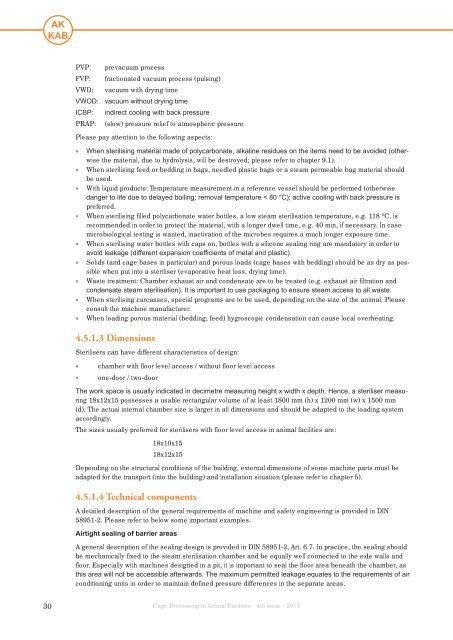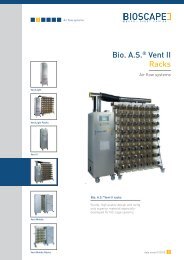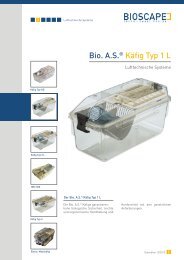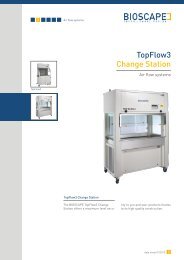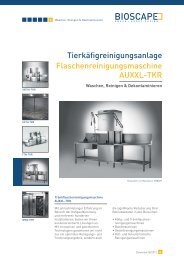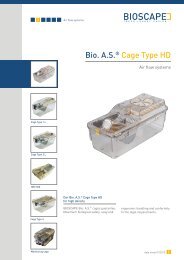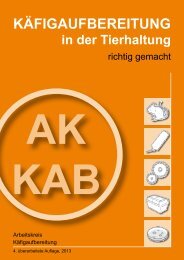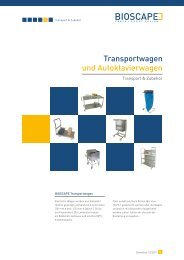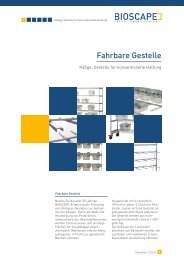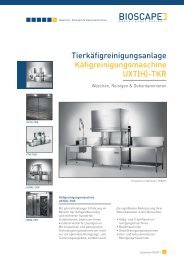CAGE PROCESSING in Animal Facilities - GV-SOLAS
CAGE PROCESSING in Animal Facilities - GV-SOLAS
CAGE PROCESSING in Animal Facilities - GV-SOLAS
Create successful ePaper yourself
Turn your PDF publications into a flip-book with our unique Google optimized e-Paper software.
PVP:FVP:VWD:prevacuum processfractionated vacuum process (puls<strong>in</strong>g)vacuum with dry<strong>in</strong>g timeVWOD: vacuum without dry<strong>in</strong>g timeICBP:PRAP:<strong>in</strong>direct cool<strong>in</strong>g with back pressure(slow) pressure relief to atmospheric pressurePlease pay attention to the follow<strong>in</strong>g aspects:• When sterilis<strong>in</strong>g material made of polycarbonate, alkal<strong>in</strong>e residues on the items need to be avoided (otherwisethe material, due to hydrolysis, will be destroyed; please refer to chapter 9.1).• When sterilis<strong>in</strong>g feed or bedd<strong>in</strong>g <strong>in</strong> bags, needled plastic bags or a steam permeable bag material shouldbe used.• With liquid products: Temperature measurement <strong>in</strong> a reference vessel should be performed (otherwisedanger to life due to delayed boil<strong>in</strong>g; removal temperature < 80 °C); active cool<strong>in</strong>g with back pressure ispreferred.• When sterilis<strong>in</strong>g filled polycarbonate water bottles, a low steam sterilisation temperature, e.g. 118 °C, isrecommended <strong>in</strong> order to protect the material, with a longer dwell time, e.g. 40 m<strong>in</strong>, if necessary. In casemicrobiological test<strong>in</strong>g is wanted, <strong>in</strong>activation of the microbes requires a much longer exposure time.• When sterilis<strong>in</strong>g water bottles with caps on, bottles with a silicone seal<strong>in</strong>g r<strong>in</strong>g are mandatory <strong>in</strong> order toavoid leakage (different expansion coefficients of metal and plastic).• Solids (and cage bases <strong>in</strong> particular) and porous loads (cage bases with bedd<strong>in</strong>g) should be as dry as possiblewhen put <strong>in</strong>to a steriliser (evaporative heat loss, dry<strong>in</strong>g time).• Waste treatment: Chamber exhaust air and condensate are to be treated (e.g. exhaust air filtration andcondensate steam sterilisation). It is important to use packag<strong>in</strong>g to ensure steam access to all waste.• When sterilis<strong>in</strong>g carcasses, special programs are to be used, depend<strong>in</strong>g on the size of the animal. Pleaseconsult the mach<strong>in</strong>e manufacturer.• When load<strong>in</strong>g porous material (bedd<strong>in</strong>g, feed) hygroscopic condensation can cause local overheat<strong>in</strong>g.4.5.1.3 DimensionsSterilisers can have different characteristics of design:• chamber with floor level access / without floor level access• one-door / two-doorThe work space is usually <strong>in</strong>dicated <strong>in</strong> decimetre measur<strong>in</strong>g height x width x depth. Hence, a steriliser measur<strong>in</strong>g18x12x15 possesses a usable rectangular volume of at least 1800 mm (h) x 1200 mm (w) x 1500 mm(d). The actual <strong>in</strong>ternal chamber size is larger <strong>in</strong> all dimensions and should be adapted to the load<strong>in</strong>g systemaccord<strong>in</strong>gly.The sizes usually preferred for sterilisers with floor level access <strong>in</strong> animal facilities are:18x10x1518x12x15Depend<strong>in</strong>g on the structural conditions of the build<strong>in</strong>g, external dimensions of some mach<strong>in</strong>e parts must beadapted for the transport (<strong>in</strong>to the build<strong>in</strong>g) and <strong>in</strong>stallation situation (please refer to chapter 5).4.5.1.4 Technical componentsA detailed description of the general requirements of mach<strong>in</strong>e and safety eng<strong>in</strong>eer<strong>in</strong>g is provided <strong>in</strong> DIN58951-2. Please refer to below some important examples.Airtight seal<strong>in</strong>g of barrier areasA general description of the seal<strong>in</strong>g design is provided <strong>in</strong> DIN 58951-2, Art. 6.7. In practice, the seal<strong>in</strong>g shouldbe mechanically fixed to the steam sterilisation chamber and be equally well connected to the side walls andfloor. Especially with mach<strong>in</strong>es designed <strong>in</strong> a pit, it is important to seal the floor area beneath the chamber, asthis area will not be accessible afterwards. The maximum permitted leakage equates to the requirements of aircondition<strong>in</strong>g units <strong>in</strong> order to ma<strong>in</strong>ta<strong>in</strong> def<strong>in</strong>ed pressure differences <strong>in</strong> the separate areas.30Cage Process<strong>in</strong>g <strong>in</strong> <strong>Animal</strong> <strong>Facilities</strong> · 4th issue · 2013


